Part 2: The Queen's Return
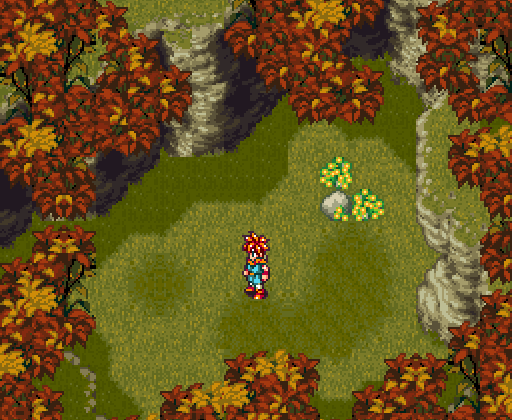
This initial mission is the closest thing the game has to a tutorial; it's a fairly straightforward area/dungeon combo with a clear goal that serves to introduce the game's primary mechanics, and it will serve the same purpose for this LP. You'll begin to get a rough sense of what playing this game at level 1 is going to entail, and you'll also figure out how long of an update you can read before falling into a catatonic stupor. Grab some popcorn and/or copious amounts of caffeine; this will be a long one.

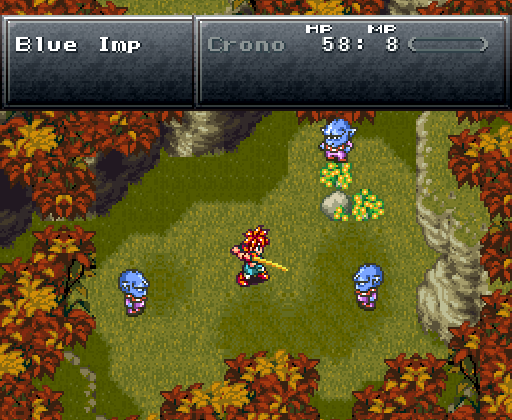
Trying to leave this field triggers our first mandatory battle. Most battles can be run from or avoided entirely (more on that in a bit), but we have to pick up the experience from this one.
Needless to say, it's not a particularly hard fight. Short strategy: Press A. Long strategy: Trigger the release of motoneurons to send acetylcholine signals to release calcium from sarcoplasmic reticula, energizing Myosin heads and breaking apart adenosine triphosphate bonds to enable muscular contractions which can be attuned so as to press A.
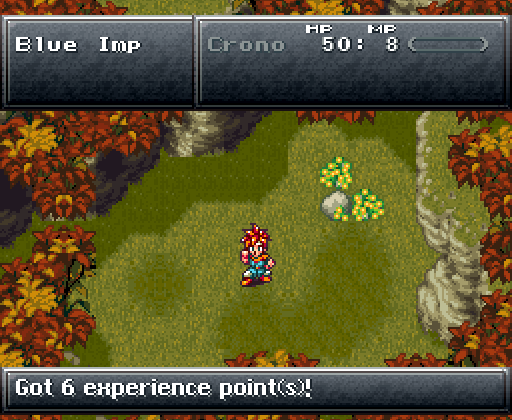
With that, Crono is done earning EXP for the rest of the game; you'll see how this works later on this update. Had we fought Gato or any other battles, Crono would gain a level here, but as it stands we're just shy of the rollover point. So why did I fight that battle last time?
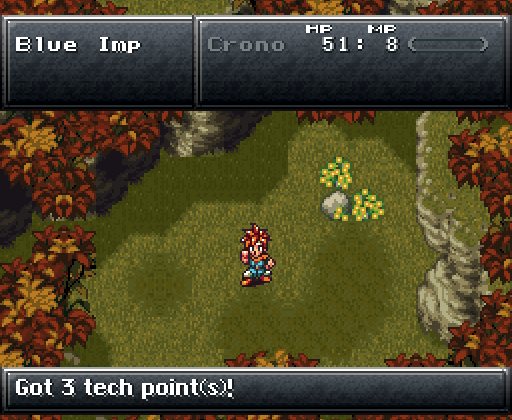
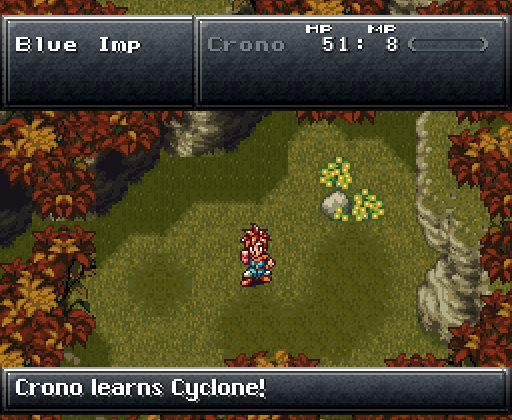
Because of this. Enemies give out two forms of experience: EXP, which define your level, and Tech Points, which enable characters to learn stronger abilities (these work the same way as magic does in most RPGs, but techs can also be physically based). The enemies we fought last time gave us Tech Points as well, and because of these Crono gets to learn his first special attack: Cyclone. This is by no means necessary, but it's a nice leg up for the first section of the game. Had we avoided that battle last update in favor of playing a Level 1 game normally (however that could be defined), we wouldn't unlock Cyclone for another ten hours.
Techs are incredibly simple to use, but they add much more variety to combat than a normal attack/magic set would. Physical techs are used to attack in different and more situationally useful ways from a normal attack, and characters can share Double and Triple techs to combine their turns and use especially powerful moves (such as setting each other's weapons on fire, electrocuting each other, throwing each other at enemies, and generally taking such a Bam Margera approach to teamwork that it's more or less indistinguishable from a battle royale). Not having access to techs is every bit as much of a detriment as having abysmally low stats, as the combat system is completely built around using them, but for the most part this can be coped with by resigning yourself to much longer battles and attempting to keep your spirits up by singing shanties.

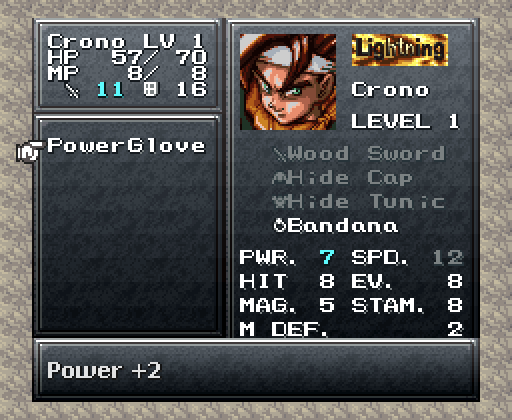
The Powerglove is our first replacement accessory, and there really isn't very much to love about it. For now its moderate stat increases are just a case of "Every bit helps", but its primary purpose is for the final boss' sixth form, where you must best him in a high-stakes duel-to-the-death game of Rad Racer.
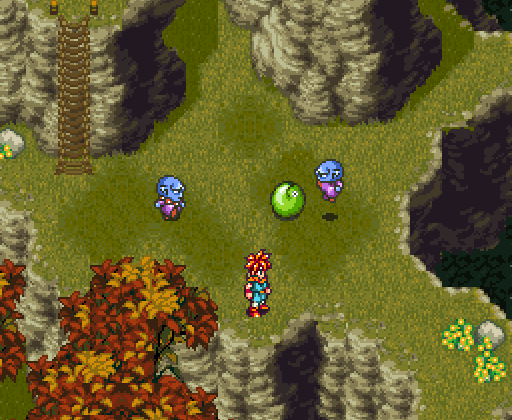
These imps are currently showing off one of the absolute greatest features of Chrono Trigger: there are absolutely no random battles. Instead, enemies occupy fixed locations on specific screens, and a battle activates when you move within range of them. Some of them are visible and avoidable, like these imps, while others appear from offscreen as you step on trigger locations, but this means that if you know your way around the game you'll never be caught by surprise.
When you do get into a battle, there's a short animation (for example, the imps stop kicking their ball and get into an attack formation), the characters pull out their weapons, menus appear, and the battle starts. When all of the enemies are defeated, the menus go away, characters sheath their swords, and you resume basic overworld control. It's probably the closest any RPG has come to integrating turn-based battles and navigation, and the transition is smooth and immediate. Not only does all of this make the game dramatically more fun to play, the sequences cinematic without taking hours to begin like some games (cough FF9 cough cough), and the battles seem like they're actually being fought by the characters rather than alternate-universe high-res facsimiles of them, but it's an absolute godsend for this type of low-level challenge. The battles are completely predictable and everything can be planned for, meaning you can actually strategize how you deal with encounters rather than simply praying that the pseudorandom mod function is feeling especially generous today.
This smoothness, of course, only applies if you're not playing the horrendously-ported PS1 version, where the animation freezes for about five seconds during each unsheathing phase and the time it takes to open up the menu is longer than the gestational period of some housepets. Then again, this may have just been an attempt to decrease the proportion of time actually spent playing the game so as not to make the newer and shinier JRPGs look bad.
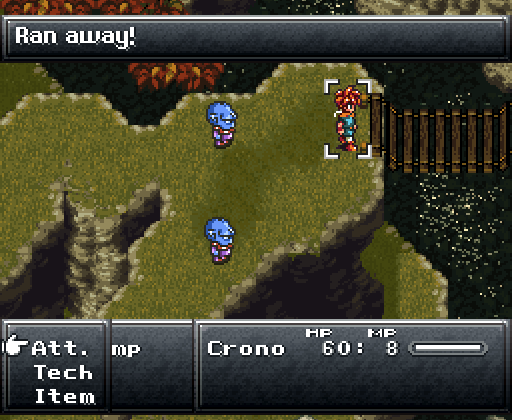
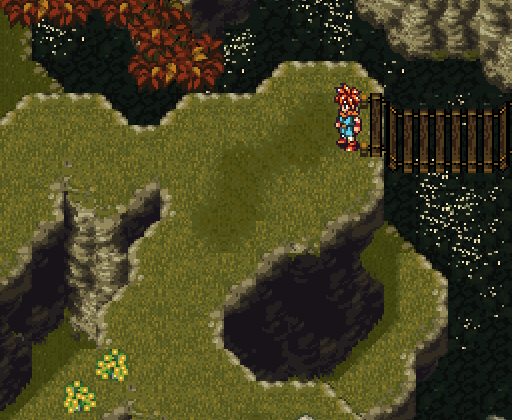
Oh yeah, and all this also means that "running away" consists of looking away for a few seconds until the enemies dissipate like some sort of anti-Boo, but I'll excuse a bit of attention whoring if it means I can save ten hours' worth of dramatic flyover pans and screen melts.

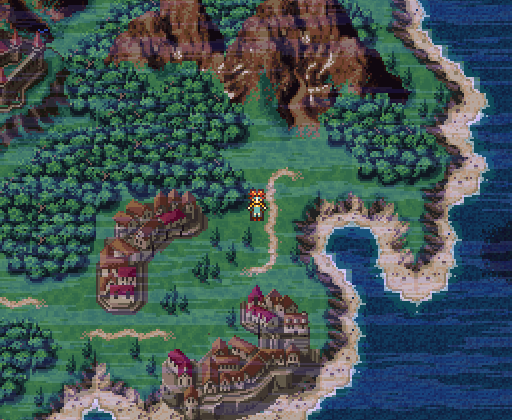
Welcome to Old Guardia, a century or two before King Guardia XXVIII became embroiled in a scandal alleging he had sold the kingdom's highest mountain to pay for a fairground (he was later acquitted on a technicality termed "being the king"). Info-gathering time!
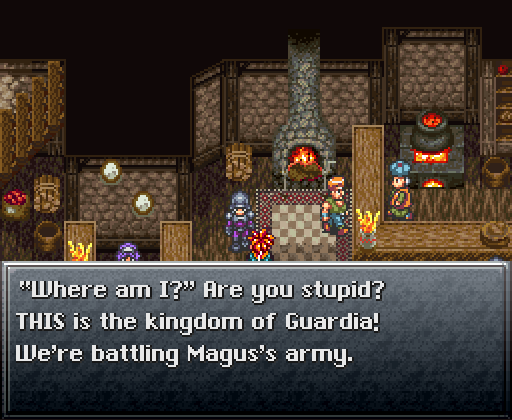
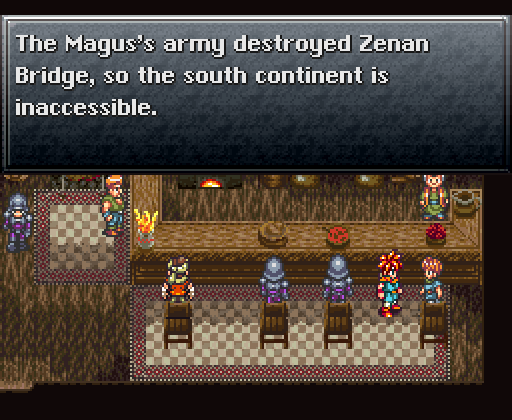
In a nutshell, the kingdom is at war with Magus and suffering from an internal lexicography debate over the proper use of the Oxford Definite Article. Oh, and this might be a good time to mention something else.
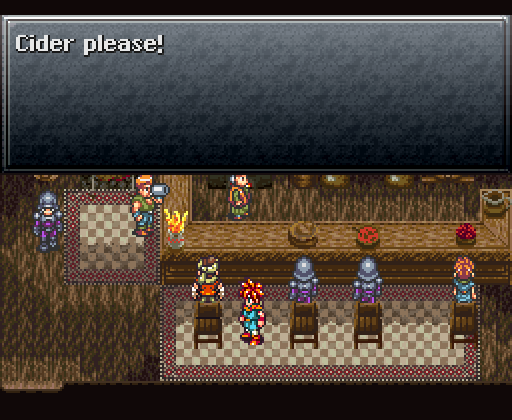
We're in a bar, and studies have found that children can more readily identify this as a bar than they can recognize triangles or discern the difference between a floral print wallpaper and their own hands. Regardless, this game was released under a Nintendo that felt that acknowledging pubs exist would make children grow up to be murderous psychopaths or friendless wash-ups who neglect interpersonal contact in order to make LPs. As such, we're currently in a cafe and these men are drinking cider.
At various points over the course of this game alcohol is replaced with cider, soda, soup, and probably [hilariously absurd thing here] given how little they care about the resulting concoction actually making sense. There's plenty more censorship later in the game, and it's primarily determined by die rolling and the relative alignment of Neptune; Nintendo of America stopped Square from describing a magic spell as "Holy", but in about five minutes we're going to start fighting snake nuns inside a demonic cathedral covered with skulls.
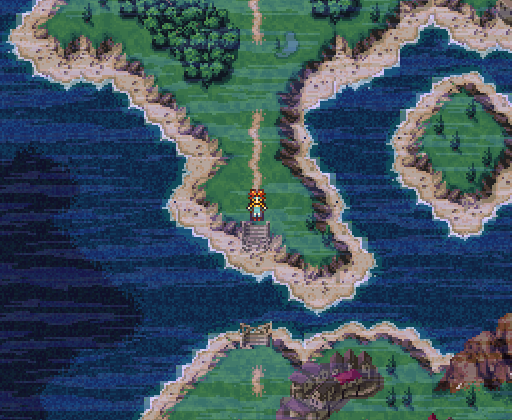
You know, having one bottleneck bridge act as your singular trade network was just asking for something like this to happen. You guys really need to come up with some kind of ferry system or something.
Despite their omnipresent war and crippling bridge shortage, medieval Guardian NPCs express a great deal of hope given that their once-missing queen has recently been found and returned to the castle. Given that regal kidnapping is a pressing concern and everybody is suspicious on account of fighting a largely unknown enemy, perhaps I should go up to the castle while brandishing my sword in the universal sign of "I am volunteering my services as a bodyguard and my refusal to speak to you merely reflects the solemn dedication with which I will perform that task". Maybe I'll get a medal!

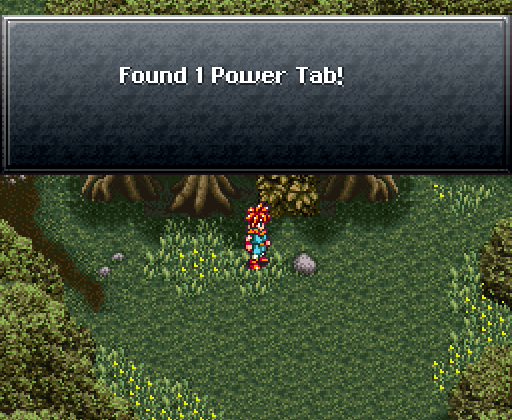

In this corner of the intervening forest we find a power tab, which increases our strength in much the same way that adding a hydrogen atom to a swimming pool increases its volume. Saying that it "increases our strength" is a bit vague, however, since about half of our stats pretend that they're other stats. To summarize (Powerglove screenshot above reused for reference):
Power is how much damage we'll do.
Hit is how often we'll do more than that through critical hits.
Magic is how much damage magic spells do.
M Def. and Stamina are magical and physical defenses.
Speed determines how fast the battle gauge fills up (more on this later also; I'm trying to space out these explanations so your eyes don't glaze over and probably failing)
Evade is the percent chance of dodging an attack.
All of these stats have a maximum of 99 except for Speed, which has a max of 16. Power also has virtually no effect on our strength compared to what weapon we have equipped, so it's completely feasible to just ignore power tabs and resign yourself to two or three more turns for major battles; chances are you aren't playing a low-level game if expedience is high on your list of priorities.
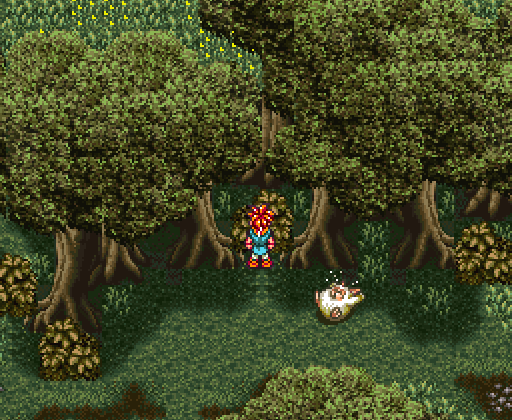
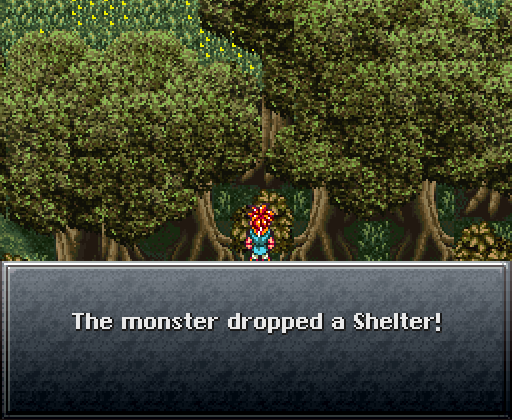
This bush gives us a shelter, which fully restores health and MP at save points or on the map. Leaving the forest and coming back in causes this to reset, so I spend about ten minutes grinding for these and gradually having an existential crisis about what I'm doing with my life. Normally I would address this feeling by playing Chrono Trigger, but I somehow feel like that would be letting the homeopaths win.

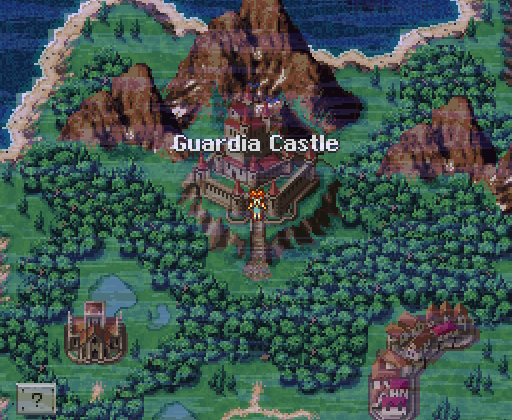
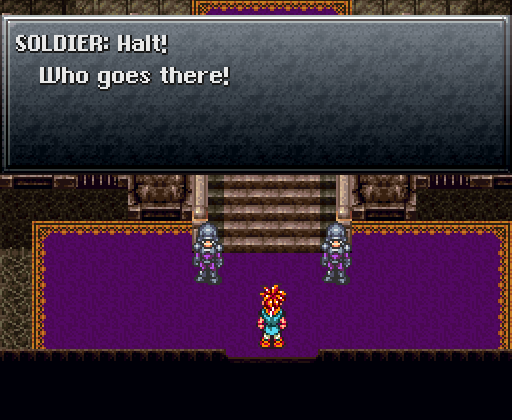
 Check out that hair! Where're you from, son? Are you one of Magus's troopers?
Check out that hair! Where're you from, son? Are you one of Magus's troopers? Hardly! This kid never would have made the cut! Show us your stamp collection, son!
Hardly! This kid never would have made the cut! Show us your stamp collection, son!Well, let's see… I have this one commemorating the war you're about to fight, and there's this antique one that was issued about three hundred years from now. I also have a collectors' set with pictures of cats on them. See this one, how her whiskers rub up against the edge of the 3? And this one, where the cat looks like he's pawing at the… You know, I can't help but feel you're being very rude to me.
 Har, har! Now beat it, shrimp!
Har, har! Now beat it, shrimp! Stop that at once!
Stop that at once!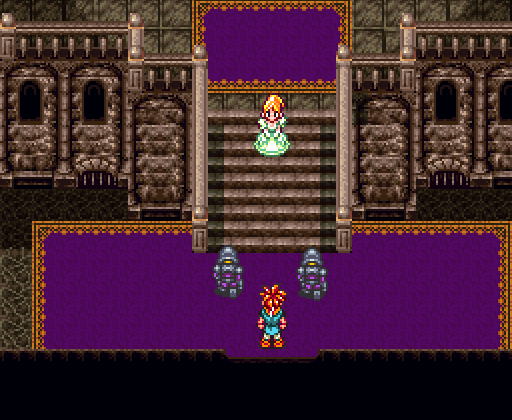
 Show your manners! This is a friend of mine!
Show your manners! This is a friend of mine! But there's something odd about him!
But there's something odd about him! You refuse to obey my orders?!
You refuse to obey my orders?! Forgive me, my lady! Please enter, Sir!
Forgive me, my lady! Please enter, Sir!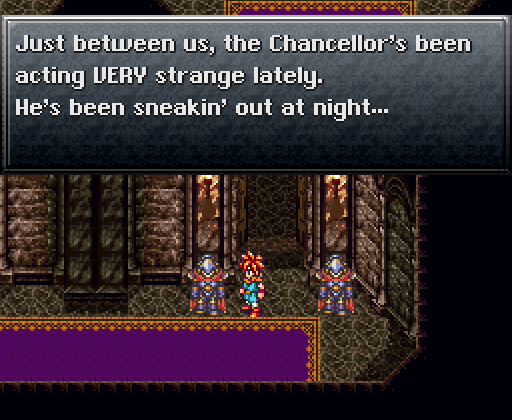
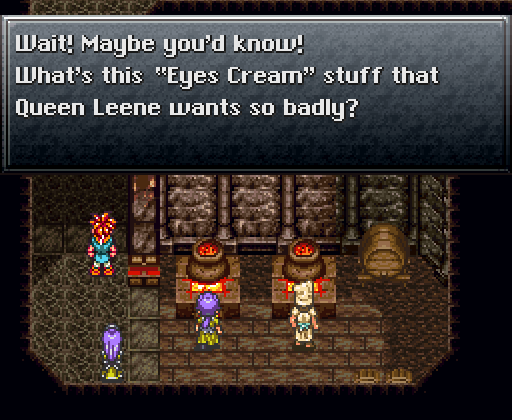
Remember what I said about subtle foreshadowing? I do, however, absolutely love that "eyes cream" line
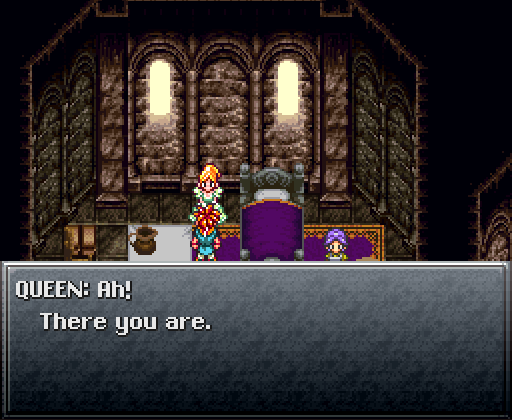
 Fooled you, didn't I, Crono? It's me! But everyone calls me Leene! I'm so relieved you're here! We barely know each other, but somehow, I knew you'd come for me... Thank you, Crono!
Fooled you, didn't I, Crono? It's me! But everyone calls me Leene! I'm so relieved you're here! We barely know each other, but somehow, I knew you'd come for me... Thank you, Crono!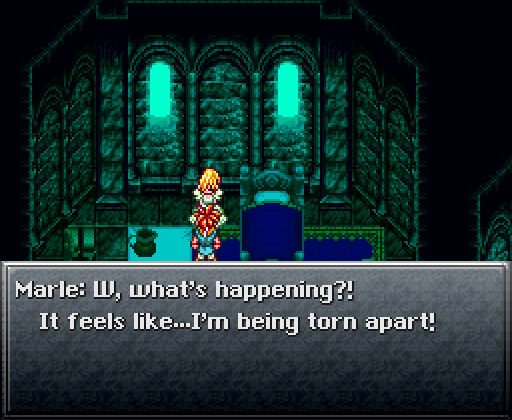
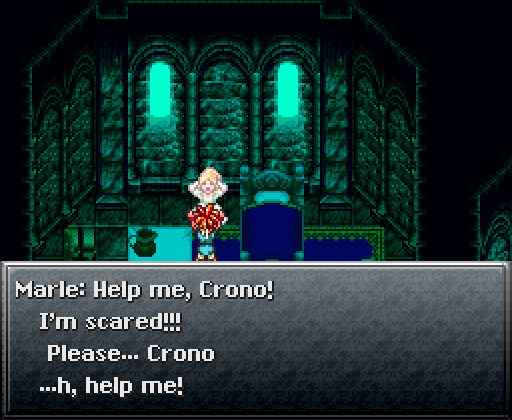
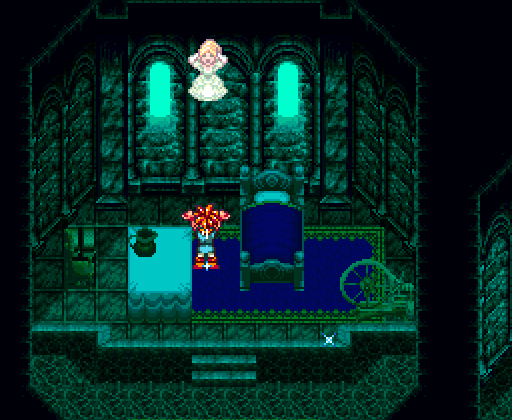
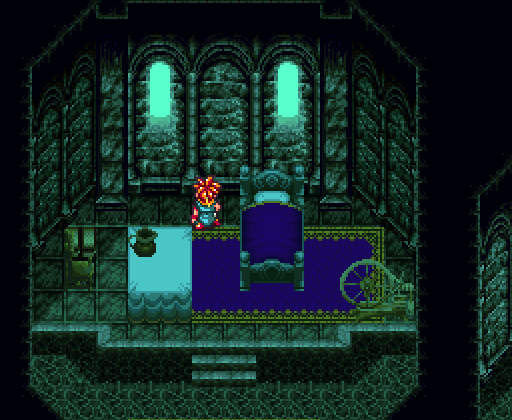
Well shit.
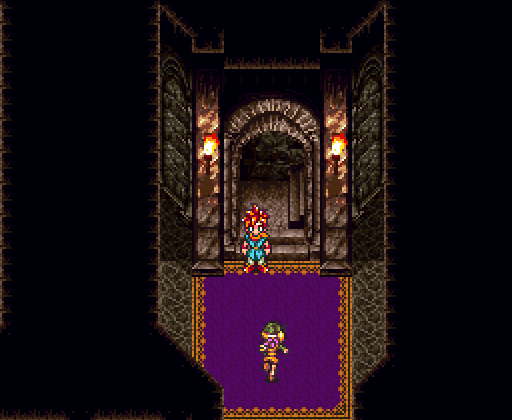
Oh, hi Lucca. The guards had no problem with you running right past here, directly towards their king, brandishing a gun? They stopped me for looking like I collect stamps. I feel that this is slightly unfair.
 Huff, puff...you're okay! Did you find the girl? Whadd'ya mean she's gone?! Hmm...it's just as I thought. I knew I recognized her! And this looks identical to the castle in OUR time! I'll bet they mistook that girl for her ancestor... You see, she's a member of the royal family in OUR time! She's Princess Nadia!
Huff, puff...you're okay! Did you find the girl? Whadd'ya mean she's gone?! Hmm...it's just as I thought. I knew I recognized her! And this looks identical to the castle in OUR time! I'll bet they mistook that girl for her ancestor... You see, she's a member of the royal family in OUR time! She's Princess Nadia!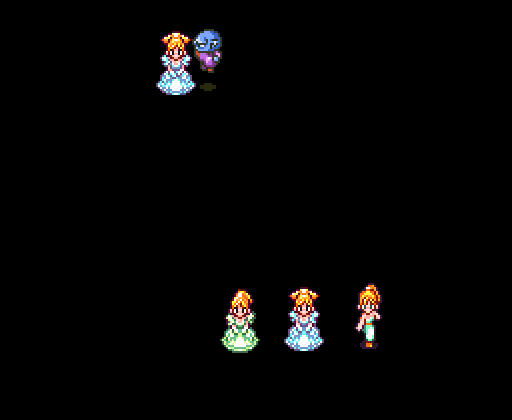
 Marle, that is, Princess Nadia, is a descendant of Queen Leene! Queen Leene has been kidnapped. Marle looks so much like Leene that they probably called off their search when she appeared here. But if the real Queen is killed... Marle will simply disappear. There might still be time! If we can save Leene, history as we know it should remain unchanged!
Marle, that is, Princess Nadia, is a descendant of Queen Leene! Queen Leene has been kidnapped. Marle looks so much like Leene that they probably called off their search when she appeared here. But if the real Queen is killed... Marle will simply disappear. There might still be time! If we can save Leene, history as we know it should remain unchanged!I really like the way Chrono Trigger deals with these sorts of paradoxes, which is basically to acknowledge them and then immediately stop acknowledging them when it becomes inconvenient. I'm serious; I actually like it a lot.
With one notable exception that I'll bitch about in time, Chrono Trigger is completely consistent in how it deals with and sets out limitations on the time travel mechanic it's built around. These limitations are just kept as broad and casual as possible. This game isn't Primer, and it doesn't pretend to be; it's a lighthearted fantasy that doesn't want to stifle your enjoyment by forcing you to read through an Isaac Asimov novel before every time jump. It's one of the many reasons why most of us Chrono Trigger fans dislike its sequel. Trigger is about how awesome teenagers can be and why traveling through time is the best idea ever, while Cross essentially says that screwing up time was a fucking terrible idea and you should all be incredibly ashamed of yourself. The team later announced that they would soon release a sequel to Super Mario Bros. where Mario's rampages destroy the kingdom's ecosystem, followed by a Modern Warfare sequel where your characters are court marshaled and called before the ICC.
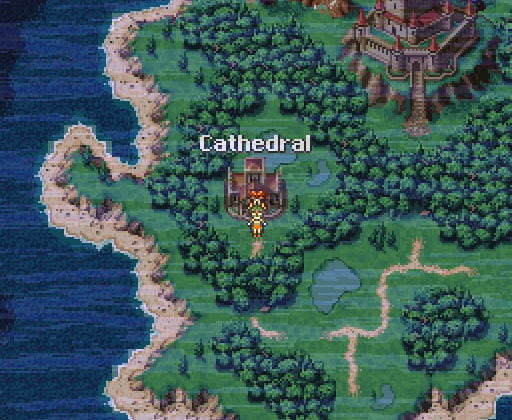
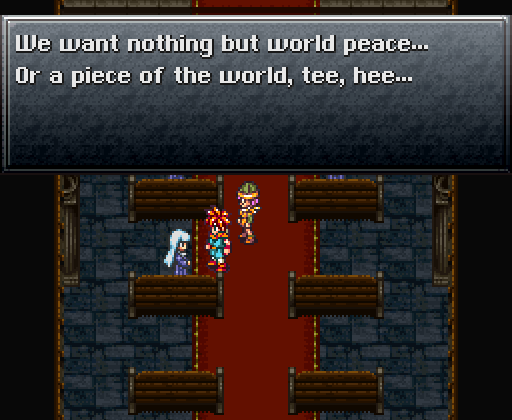
Crono's been having a very bad day, and like most of us he finds that one of the best ways to blow off some steam is to beat up Catholics. This Cathedral is going to be our first dungeon, and it's going to be fairly painless for all concerned.

 A hair pin. That's Guardia's royal crest!
A hair pin. That's Guardia's royal crest!
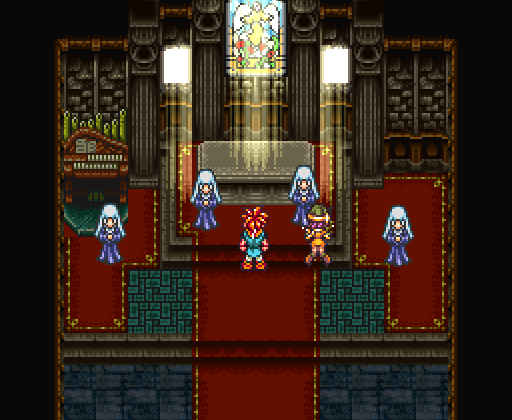
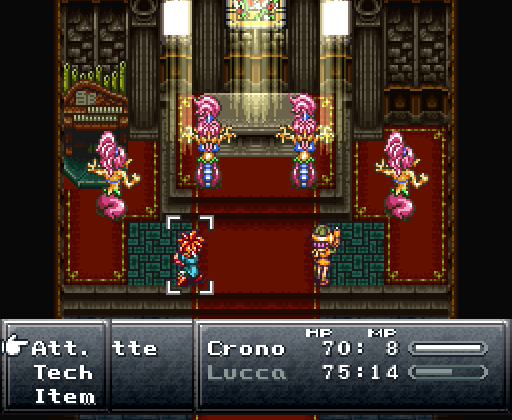
Except for Crono; Crono's going to get whacked because he's weak.
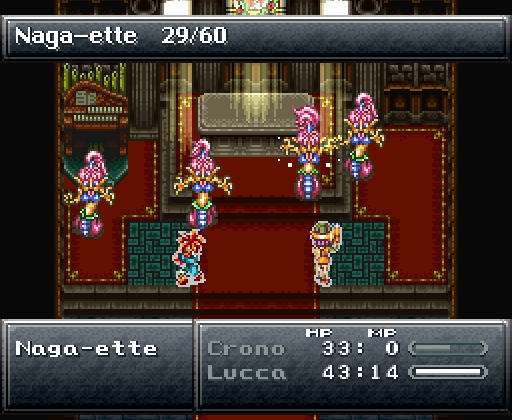
Battle explanation, part 2:
Normally, fighting a couple of battles would cause Lucca to learn Flame Toss, and in turn we would be able to pull off Fire Whirl, our first Dual Tech. These attacks can kill the Naga-Ettes (snake nuns) in one hit, and their high physical defense encourages you to play around and discover this.
Unfortunately, we don't have that luxury, and the combination of our attacks dealing little damage and the Naga-ettes having a Slow spell makes this fight take about as long as a magic animation in any other JRPG. Thankfully, the Cyclone tech we got can alleviate this at least mildly.
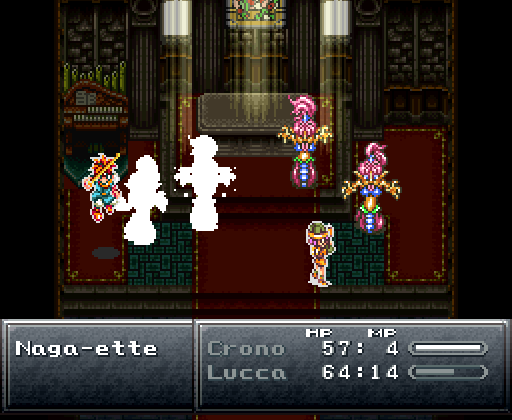
Cyclone is slightly less powerful than a normal attack, but it can target a group of enemies located close together. During battles, enemies constantly move around, and adjusting your strategy to where they are on screen is vital. It's another one of the neat features CT introduces that makes the game far more engaging without making it overly complicated or difficult to understand, but unfortunately after this game's release the entirety of Square's board of directors suffered from simultaneous bouts of collective amnesia. If you've never played Chrono Trigger but all this talk of smooth battle transitions, no random encounters, and relevant positions seems familiar, it's because Square-Enix is just now starting to experiment with identical concepts… in Final Fantasies 12 and 13. For comparison's sake, this game came out right after Final Fantasy 6, but Square felt these ideas weren't really worth further developing as they instead allocated more funding to their anime and belt rendering divisions.
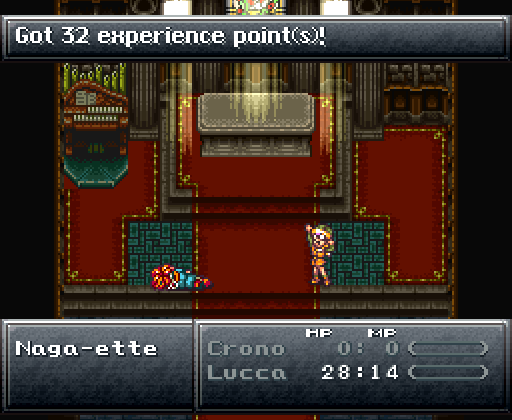
Crono needs to be dead by the time the final blow is landed so as to avoid gaining experience, and this is going to be the case for a long time to come. One day, these characters will be sitting on a porch somewhere recounting their old adventures, Lucca will regale them with stories of high-stakes combat and infinite close encounters, and Crono will feebly try to explain (via semaphore or something) that time that he managed to take out some mushrooms and three whole imps.

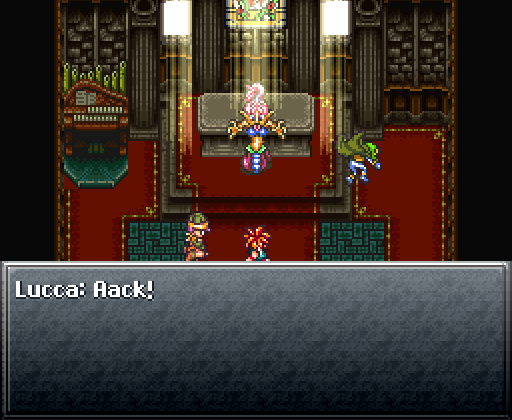
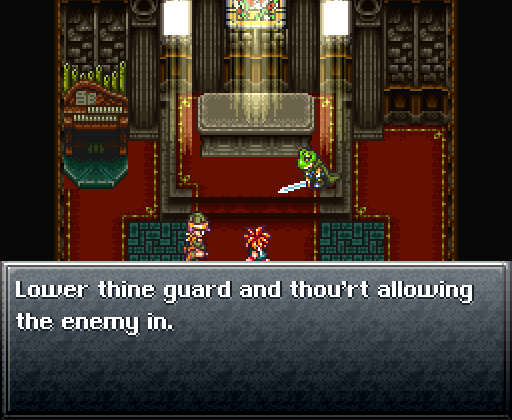
The amphibian who was apparently waiting in the rafters just in time to help us when we needed it least is Frog, who I will unironically say is one of the best characters in any video game I've played despite the fact that in doing so I probably sound like I'm 12. There are four principle reasons for this:
1. He has a fantastic character arc, well-written backstory, believable flaws, and satisfying development.
2. He can forever challenge your perceptions of whether frogs have whiskers and if your head truly is larger than your fist.
3. Oh wow did you just see him cut that stuff in half like it was nothing oh my god you'll never believe it come here mom look at this!
4: This:
 Thou'rt here to save the Queen? The lair is deep within. Will thee accompany me?
Thou'rt here to save the Queen? The lair is deep within. Will thee accompany me? A...a FROG!? Crono, it's a talking FROG! I hate frogs!
A...a FROG!? Crono, it's a talking FROG! I hate frogs! My guise doth not incur thy trust... Very well, do as thee please. But I shall save the Queen.
My guise doth not incur thy trust... Very well, do as thee please. But I shall save the Queen. W, wait! You don't seem like a bad... ...uh, person-frog-thing... I'll just have to handle it! I mean... What's your name?
W, wait! You don't seem like a bad... ...uh, person-frog-thing... I'll just have to handle it! I mean... What's your name? Frog will do.
Frog will do.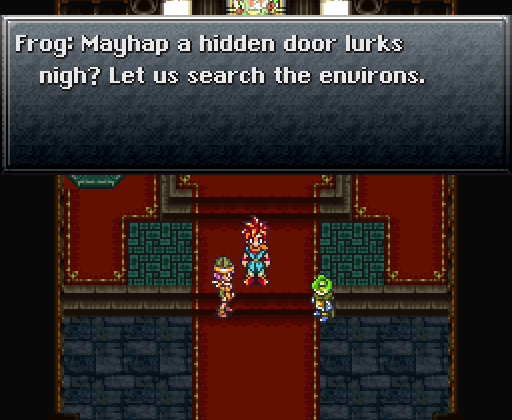
To contextualize this last one, it's worth talking a bit about this game's translation (I told you this update was a long one).
Final Fantasy 7 is the game that made JRPGs into the blockbuster genre they were throughout the PS1-PS2 era; before that game's overwhelming success, RPGs were a niche genre that received fairly little Western attention. The US market was considered to be a footnote and the European market was considered about as important as that of Southeastern Gabon. As such, the notion of spending money on the creation of dedicated translation teams was dismissed outright, and Square instead gave the task of translating many of its Super Nintendo games to one man: Ted Woolsey.
Ted Woolsey was not treated very well. For both this and FF6, he was given roughly a month to translate thousands of lines of dialogue by himself in accordance with strict NoA content standards and with little oversight. Woolsey's response to these conditions was to basically go nuts, taking perhaps the most liberal approach to translating that one can take without replacing all of the dialogue with song lyrics and excerpts from Das Kapital. He completely recreated allusions and naming schemes, made up character traits out of thin air, and inserted a lot of incredibly corny and ridiculous lines. Needless to say, fans are divided over whether Woolsey reinvigorated these games or slaughtered them, and I put myself firmly in the former category.
Originally, Frog spoke normal Japanese, and not even in a semi-formal way. For some inexplicable reason, Ted Woolsey decided to instead make up dialogue that sounded vaguely Shakespearean and have Frog speak in Ye Olde English while not bothering to A) actually learn anything about Shakespearean dialects or B) do this to anybody else in the middle ages. It's stupid, it makes no sense, it's completely ridiculous, and I love it. The DS version dramatically tones down Frog's speech patterns (this line becomes the far blander "This room must conceal a secret passage. Let us search every corner!"), and, to use an argument that basically boils down to "I do not like change at all", I feel this costs the character a lot of his charm. The fact is, his absurd speech makes the character into a buffoon, which completely fits who he is and makes his character arc all the more meaningful. It's the same as Kefka's absurd ramblings making him a far more imposing villain, and come on, if you're going to write an anthropomorphic amphibian knight and not have your tongue at least slightly in cheek then I think you're being disingenuous with the concept of your game.
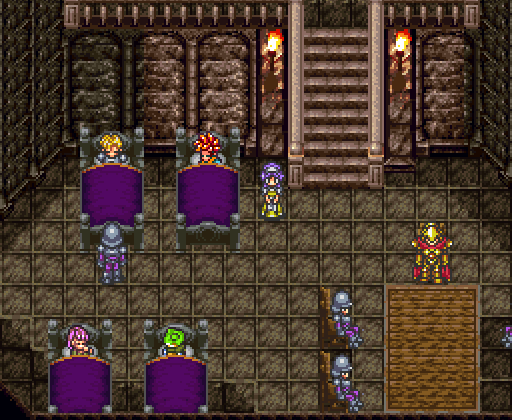
Since Crono is dead, we take a detour to the castle which is also an inn. We could spend a whopping 10 gold to actually use the inn, but this gives me an excuse to grind shelters for two more hours while telling myself how frugal and efficient I'm being.
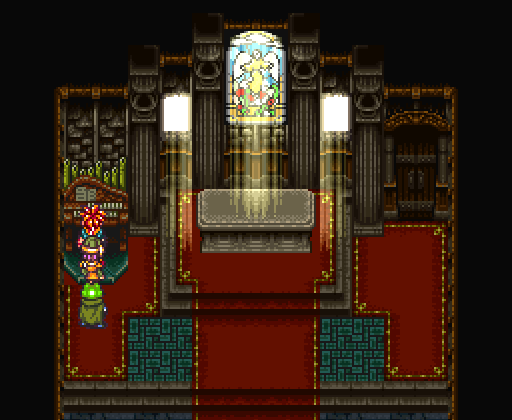
Then we return to play a moving song to open up a hidden door leading to a maze of hallways. Apparently we're now playing Resident Evil.
This cathedral is incredibly straightforward; the first section consists of a straight hallway with a few offshoots and the second is based on hitting the proper switch. A few things are worth exploring here, though for two of them I'm going to wait until after we've cleared the dungeon (as they lead to inescapable encounters)

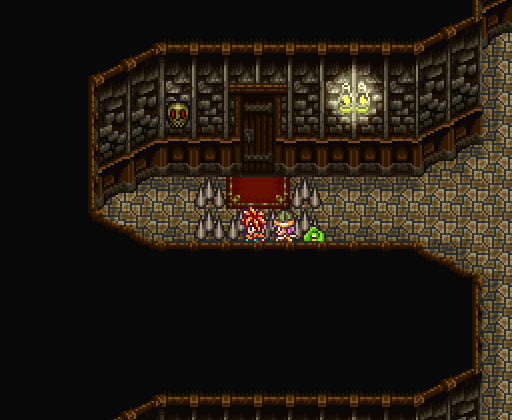
This is a perspective trick; the spikes don't actually block you from hitting this switch that makes them retract. I don't understand why they would build this trap when from the party's perspective it leads to absolutely no confusion or inconvenience at all, but that can of worms leads to asking how they rigged locks to organ keys and why nobody ever noticed that the inside was about 5% as big as it should be. It's not worth questioning; some things are not for men to know. (By the way, the point of going into this room is a power tab)
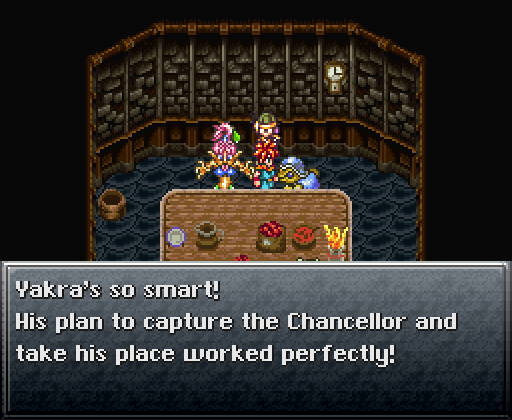

Other rooms demonstrate that all of these monsters are excellent shapeshifters; some of them don't attack you because they assume you're infiltrating human culture and still in the useful and inconspicuous disguises of frogman, Goku, and pink-haired space woman. This message hasn't gotten to the numerous other monsters in the cathedral, who apparently attack at random and sort out the human/coworker distinction later. That must look positively dreadful on their yearly review.
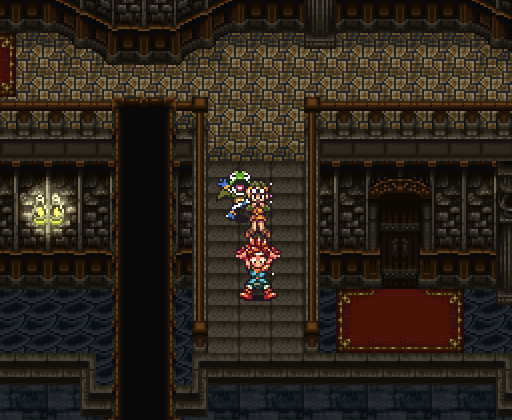
After that hallway we come to the second half of this rather short dungeon, where we have to hunt around for some skull switches so as to open more doors. There are a couple of traps, but nothing major, and I can't imagine they do much beyond inconvenience the monsters who work here and drastically decrease accessibility for anyone with a bad hip.
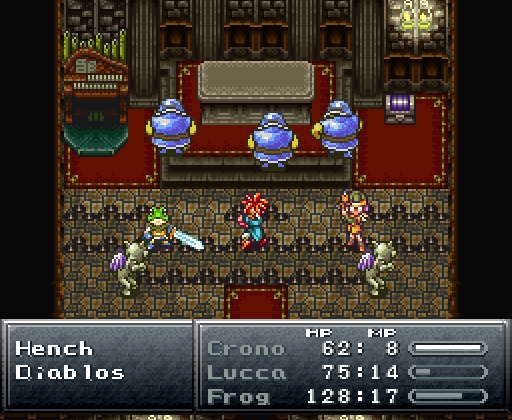
A skull switch on the right side of the lower level makes these spikes retract, so looping around to another non-trick staircase (the trick one is whichever you step on first) gets us into the game's third inescapable battle. I think this cathedral alone has a higher population than the country with which they're at war.
Alright, let's go over our modus operandi for battling:
Lucca has an item called the Sightscope, which lets us see enemy HP, and I have an item called GameFAQs that serves roughly the same purpose. When the last enemy is defeated, experience is given to every party member who's still alive, with everyone outside the current party (i.e. Marle) getting 75% of what the people who actually did something get. When the last enemies are close to death, then, we wait until two of our characters are knocked out (Frog comes equipped with a tech called Slurp, which heals characters by a small amount and can be used to keep the experience-absorbing character alive) so that only one active character gets any closer to gaining a level. For now, Frog is the designated absorber, which means he's also the only character to absorb tech points. We're not going to fight enough enemies for this to make any difference, unfortunately, and characters outside the party don't get any of the Tech Point bounty. At the end of every battle, all dead characters get restored to 1 HP, so Frog unfortunately doesn't get any stylish corpse backpacks for his struggles.

This next hallway (opened by playing the organ in the spike room) demonstrates another nice thing about enemy placement: they move in patterns that reward quick reflexes and effective weaving (well, okay, they punish these things by making you underleveled and less powerful, but play along). We can avoid all of these encounters by running around them, since the strict military regiment these henchmen follow prioritizes ordered marching over actual dispatching of threats. You laugh, but the Chrono Trigger Enemy Parade is going to be a tremendous hit this year, just wait.
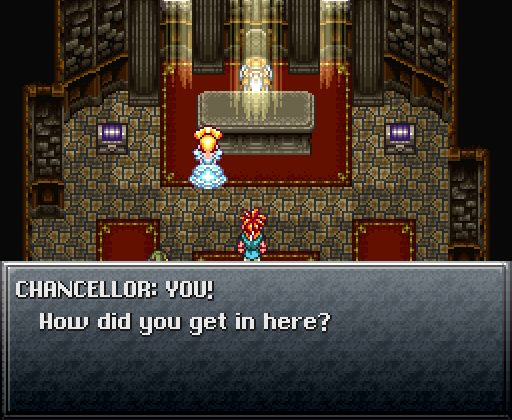
 Frog!
Frog! Majesty, stand back and allow us the honor!
Majesty, stand back and allow us the honor! Stupid frog! It's time you jumped off this mortal coil! True-form...CHANGE!
Stupid frog! It's time you jumped off this mortal coil! True-form...CHANGE!That doesn't even make sense. You can't just throw a pun and half a Shakespeare line together and pretend it's a clever one-liner.
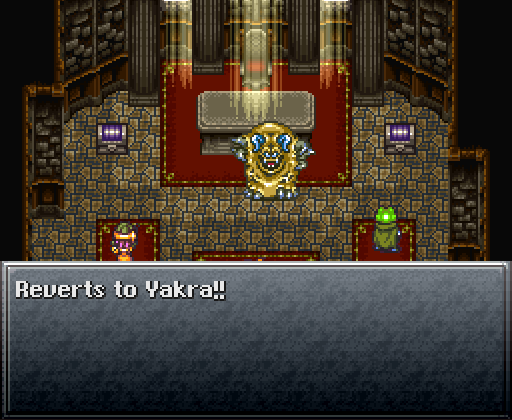
 Now, let the Magus whom though still hast served tell thee, Crono was from his leveling up untimely stopped.
Now, let the Magus whom though still hast served tell thee, Crono was from his leveling up untimely stopped. Kindly cease; thou'rt embarrassing me.
Kindly cease; thou'rt embarrassing me.
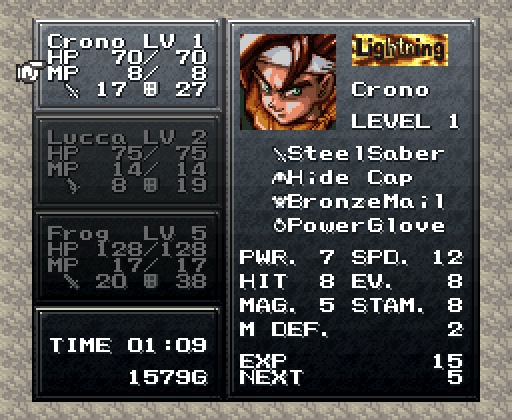
Chrono Trigger isn't a very difficult game, but you will get slaughtered if you don't pay attention to what you're doing. Yakra is a primer in that, and it's not uncommon to die at least once before catching onto the strategy you need to use. With that in mind, it's time for gameplay mechanic lecture #2000.
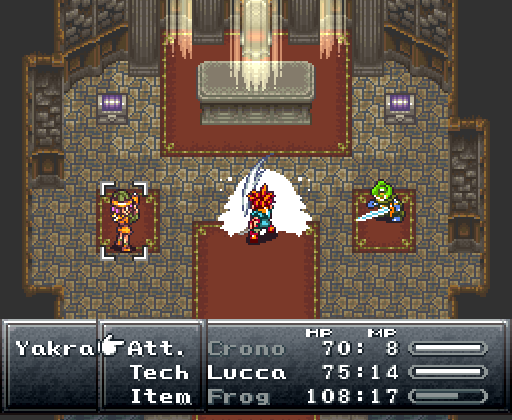
Yakra spends most of his time shambling around the room, and the fact that he rarely attacks you essentially tricks you into thinking you can just get into a damage race. When you attack, however, he counterattacks against the whole party, unless he's close to the character that did the attacking.
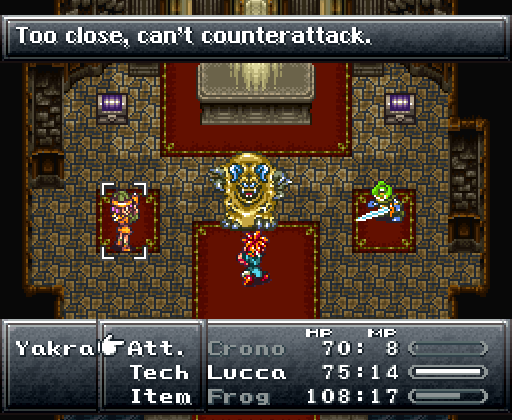
In this case, Yakra's crippling social anxiety causes him to momentarily forget that he's a giant spiked monstrosity and instead break down in manly, internal tears. The point of this battle, then, is to be patient and wait for the right opportunity to fight back.
Unfortunately, we're currently at level 1. The whole point of placing Yakra after a cathedral full of monsters is so that the game can reasonably assume that we fought more then four of them, giving Yakra a fair bit of health and all but screaming "Use techs, idiot; that's why they're there." Instead, this is basically a battle of attrition where Yakra eventually dies from the equivalent of being flicked with pebbles.
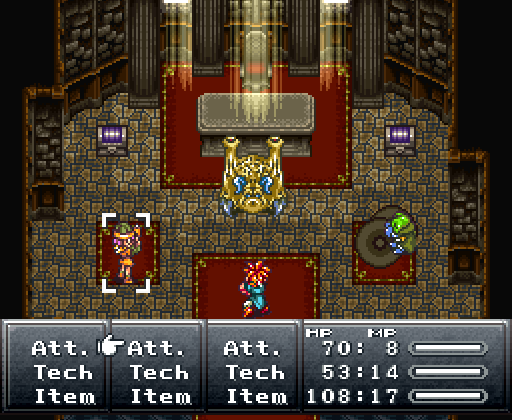
The way that turns work in this game is a bit different from most. Each character has an ATB (Active Time Battle) gauge, as does each enemy, which fills at a speed determined by their speed stat. Whenever somebody's is filled, they can attack, regardless of what the other side is doing. If you just sit there, for example, even if every character is ready to attack, enemies will continue to assault you until you die. This adds an important element of timing to a battle, especially where healing is concerned, and a big part of the strategy of a low-level run is pacing your attacks so that they happen at strategic points relative to an enemy's move sequence. The game gives you the option to choose between Active and Wait gauges, but the only difference is that Wait stops the battle when you're cycling through a menu while Active lets enemies attack you even then. While I would normally choose Active, it's simply too unforgiving for what I'm trying to do so I've regrettably lowered myself to the level of a philistine and used Wait. If you aren't planning to beat Lavos at level 1 and you choose Wait anyway, you have no excuse and you're probably less of a man.
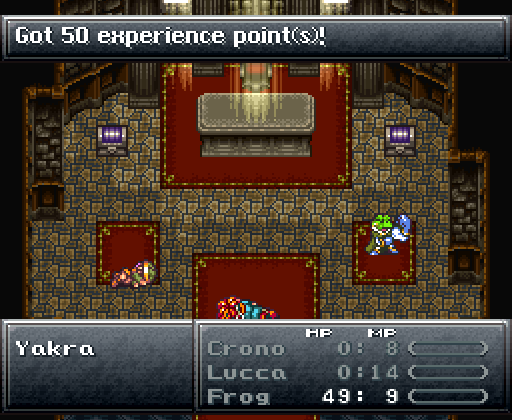
Alas, poor Yakra. You actually didn't give me any difficulty at all; I didn't even have to use a single tonic (healing items; no, I don't know why they aren't called potions).
As a whole, I like this opening. Like I said before, there's plenty to see but it's also incredibly easy to streamline, and you get a thorough introduction to the game's mechanics without anything being forced down your throat.
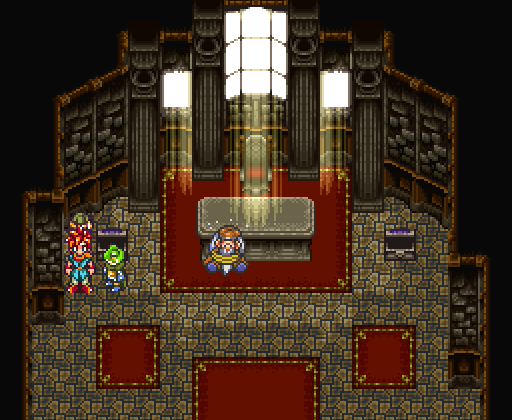
We can also rescue the real chancellor here, but this doesn't particularly matter. If we leave without doing so, the Chancellor will break out of the ropes and chest by himself, suggesting either that Yakra failed basic Boy Scout training or that Guardia currently employs the most extreme government official since Teddy Roosevelt.

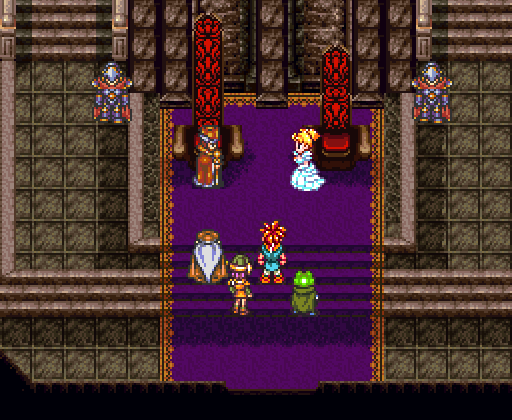
 I failed to protect Queen Leene. I hath disgraced thee.
I failed to protect Queen Leene. I hath disgraced thee. That no good Yakra! Impersonating me and kidnapping the Queen! We MUST create a criminal justice system in this Kingdom to do away with such fiends.
That no good Yakra! Impersonating me and kidnapping the Queen! We MUST create a criminal justice system in this Kingdom to do away with such fiends.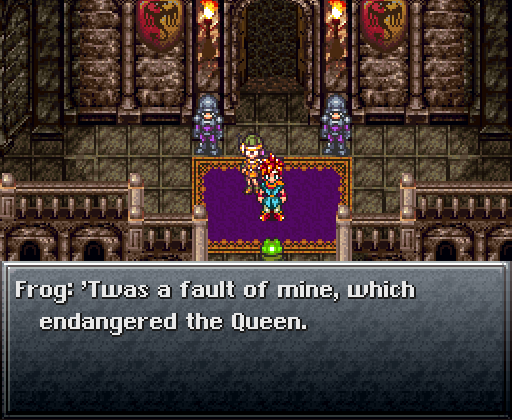
 Crono, you hath potential to be a good swordsman!
Crono, you hath potential to be a good swordsman! ...Froggy, you weren't such a bad guy either.
...Froggy, you weren't such a bad guy either.This is part of why I think Frog's terrible speech patterns work; he is a buffoon, and he's not particularly good at his job. Sure, he can leap from rafters fairly effectively, but he's clearly too enamored with the ideals of knighthood to show the pragmatism that's required for it and his capabilities are often overshadowed by his eccentricities (such as being a frog). That's a fantastic starting point for a character arc, and he- Oh right, there's something else we need to do.
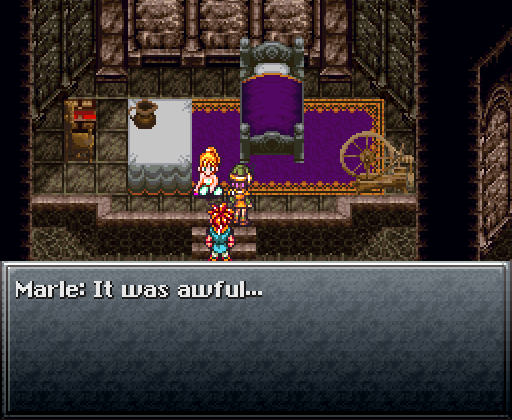
 I was somewhere cold, dark...and lonely. Is that what it's like to...die?
I was somewhere cold, dark...and lonely. Is that what it's like to...die? Welcome back, Princess Nadia!
Welcome back, Princess Nadia! I guess you guys figured it out, huh? Sorry, Crono. I didn't mean to deceive you. The real Queen's safe, right? So let's go home, Crono!
I guess you guys figured it out, huh? Sorry, Crono. I didn't mean to deceive you. The real Queen's safe, right? So let's go home, Crono!One of the many reasons the lighthearted atmosphere fits this type of game is that it still allows you to get away with some legitimately dark moments, while trying to put humor into a "dark" and "edgy" title doesn't tend to work particularly well. Chrono Trigger and most of Square's later RPGs can be contrasted fairly well through these approaches: CT's normal moments involve Shakespearean frogs being badass while its unconventional moments involve Marle recounting the horrors of nonexistence; meanwhile, FF7's normal moments involve black people with guns for arms swearing about cyberpunk class struggle while its unconventional moments involve accidentally wandering into a gay bathhouse in an attempt to find makeup. Winner: Frogs.
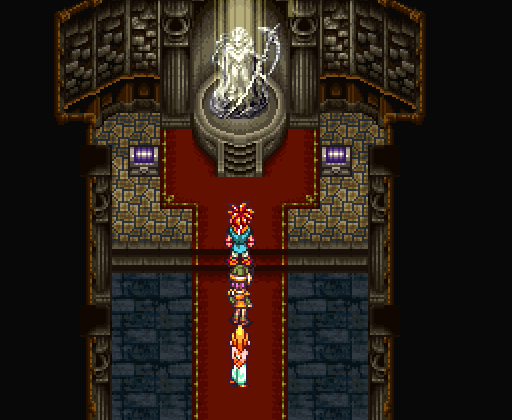
The enemies are gone from the cathedral now, so I can show off the last two things without getting into the inescapable encounters they entail. First is this side room, where we can see a statue of definitively-not-Jesus. This is Magus, and he normally has a group of monsters worshiping him, though they don't fight you (they assume you're also monsters and are just still wearing a disguise, but another group forces a mandatory encounter on your way out). The main point of coming here is collecting some items, which I'll go over in an update that isn't already exceeding 5000 words.
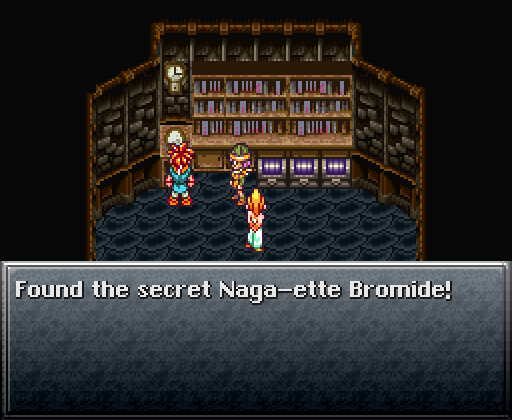
Over in this room we can now pick up the ever-inexplicable "Naga-ette Bromide". Had we grabbed it earlier, a group of monsters would have barged in to defend their priceless Catholic halogen oxidation to the death, albeit from people who probably have no idea what it does.
Since the Bromide doesn't appear in your inventory and is usually long-forgotten by the time you can do anything with it, most players assume it's an inexplicable joke lost in translation or an example of Ted Woolsey being Ted Woolsey. In fact, a bromide is a Japanese pin-up, and you can eventually trade this to an old man for a Magic Tab. Sadly, I'm entirely positive that there is actually a market for erotic pictures of snake women. 4Chan has probably had a name for the fetish since 2004.
With that, we're done with the middle ages for the time being. Time to return home; this time period doesn't have nearly enough cats.

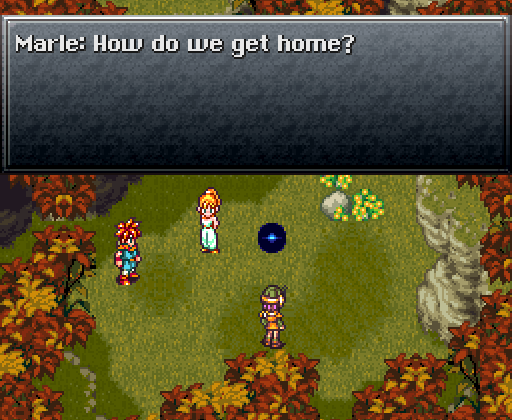
 How do we get home?
How do we get home? Your Highness, er, Princess...we...
Your Highness, er, Princess...we... Please call me Marle!
Please call me Marle! Well then, Marle... Observe!
Well then, Marle... Observe!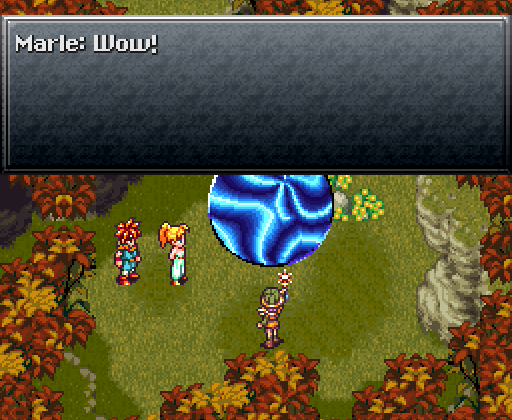
 Lucca! You're amazing!
Lucca! You're amazing! Ain't it the truth! Oh, um...I mean...
Ain't it the truth! Oh, um...I mean... Enough with the false modesty! You have a real gift! I would trade my royal ancestry for your genius in a heartbeat!
Enough with the false modesty! You have a real gift! I would trade my royal ancestry for your genius in a heartbeat! Anyway, I call this thing a Gate. It's a kind of portal, that takes you to the same location in a different era. Gates are very unstable, so I used the principle behind my Telepod device to create a Gate Key. Now we can use them as we please.
Anyway, I call this thing a Gate. It's a kind of portal, that takes you to the same location in a different era. Gates are very unstable, so I used the principle behind my Telepod device to create a Gate Key. Now we can use them as we please.You used the principle of a machine that enables travel through space and not time to make a machine that enables travel through time and not space? That's an impressive "modification"; almost as impressive as that time I modified a zeppelin into a submarine.
 But why did this Gate suddenly appear?
But why did this Gate suddenly appear? Either the Telepod had something to do with it, or...something else made it.
Either the Telepod had something to do with it, or...something else made it. This is getting pretty weird. Let's at least head back to our own time!
This is getting pretty weird. Let's at least head back to our own time!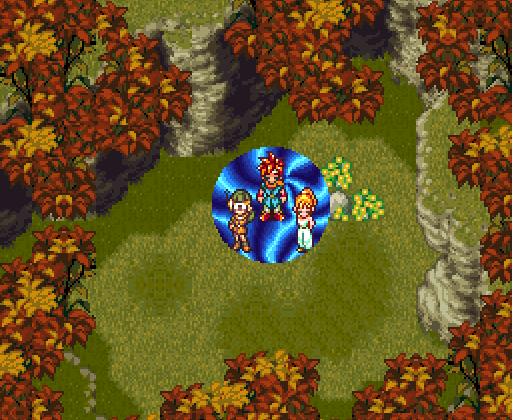
Congratulations; you just survived the Let's Play equivalent of your mother-in-law showing travel photos while disjointedly rambling about making quiche. I've gotten my essays out of the way already, so in lieu of writing a long closer I'll just reiterate that this is a fantastic way to start out a video game. Next time, we'll actually return to the castle, and Crono will demonstrate his affinity for Pink Floyd's work post-Animals. See you then, and perhaps I'll have learned what editing is.